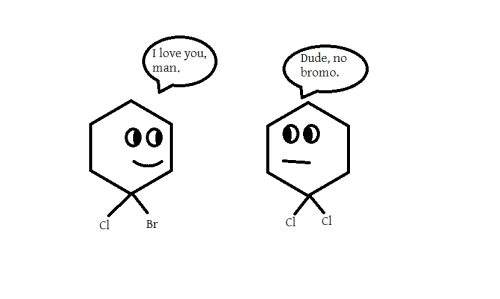Search found 12 matches
- Wed Mar 15, 2017 5:33 pm
- Forum: *Alkenes
- Topic: Homework Problem 2.47
- Replies: 1
- Views: 1374
Homework Problem 2.47
For question 47 in Chapter 2, we're supposed to identify the functional groups present in the hormone testosterone. The answer says that alkene is one of the functional groups, but I don't understand why that is. The alkene is present in the form of a double bond in a cyclohexene structure.
- Wed Mar 15, 2017 11:34 am
- Forum: Administrative Questions and Class Announcements
- Topic: Saying Thank You to Dr. Lavelle
- Replies: 490
- Views: 553740
Re: Saying Thank You to Dr. Lavelle
Dear Dr. Lavelle, Thank you so much for all the hard work and effort you put into teaching us this year! I appreciate the countless resources that you provide us, from review sessions to peer learning sessions. I truly feel that you want every single one of us to succeed, not just in your class, but...
- Wed Mar 08, 2017 6:00 pm
- Forum: Student Social/Study Group
- Topic: Post All Chemistry Jokes Here
- Replies: 9651
- Views: 3607868
- Fri Mar 03, 2017 3:34 pm
- Forum: *Ketones
- Topic: ketone placement
- Replies: 1
- Views: 1459
ketone placement
Dr. Lavelle mentioned that aldehydes must be at the end of a carbon chain, but ketone can never be at the end. Can someone elaborate on why that is structurally?
- Thu Feb 23, 2017 11:53 am
- Forum: Administrative Questions and Class Announcements
- Topic: Quiz 2 Winter 2017
- Replies: 160
- Views: 24797
Re: Quiz 2 Winter 2017
For #8, how do you get your units to become 6.06 minutes? I know you have to use the first-order integrated rate law to find the time. I did ln(0.35 M/1.50 M)/-4.00*10^-3 s^-1 Is this correct? Yes your equation is correct. Look at the rate constant units, it's expressed in seconds. So the answer yo...
- Thu Feb 23, 2017 11:51 am
- Forum: Administrative Questions and Class Announcements
- Topic: Quiz 2 Winter 2017
- Replies: 160
- Views: 24797
Re: Quiz 2 Winter 2017
Could somebody explain #5 to me? Why is it that the temperature doesn't change the rate much? Dr. Lavelle said that we don't need to know how to do #5. But to answer your question, refer to page 75 on the course reader and look at the bottom graph. Reactions with low activation energies have flatte...
- Tue Feb 14, 2017 2:50 pm
- Forum: Third Law of Thermodynamics (For a Unique Ground State (W=1): S -> 0 as T -> 0) and Calculations Using Boltzmann Equation for Entropy
- Topic: Midterm Winter 2013 problem 5B
- Replies: 10
- Views: 1812
Re: Midterm Winter 2013 problem 5B
I think the official explanation is that because F is a more complex atom than H, the more F atoms a molecule has, the more standard molar entropy the molecule possesses. However, I don't understand that explanation either, because wouldn't molecular complexity be more important than atomic complexi...
- Thu Feb 09, 2017 11:03 pm
- Forum: Student Social/Study Group
- Topic: Post All Chemistry Jokes Here
- Replies: 9651
- Views: 3607868
- Thu Feb 02, 2017 11:43 pm
- Forum: Third Law of Thermodynamics (For a Unique Ground State (W=1): S -> 0 as T -> 0) and Calculations Using Boltzmann Equation for Entropy
- Topic: Negative Entropy
- Replies: 1
- Views: 477
Re: Negative Entropy
I don't think you should worry too much about negative entropies. Usually entropy is measured as delta S, or the change in delta S. A negative delta S indicates that the possible microstates (amount of "disorder") has decreased from previously. The only time that molar entropy is negative ...
- Thu Jan 26, 2017 5:33 pm
- Forum: Gibbs Free Energy Concepts and Calculations
- Topic: Course Reader Pg. 29
- Replies: 1
- Views: 395
Re: Course Reader Pg. 29
Yes. In that example, you need a high temperature in order for the reaction to be spontaneous. Since the reaction will reach equilibrium at 333K, any temperature higher than that will then make the reaction spontaneous.
- Fri Jan 20, 2017 10:56 am
- Forum: Reaction Enthalpies (e.g., Using Hess’s Law, Bond Enthalpies, Standard Enthalpies of Formation)
- Topic: Bond enthalpy problem solve
- Replies: 1
- Views: 409
Re: Bond enthalpy problem solve
You can count all the bonds of the molecule to calculate bond enthalpy. However, an easier way is to see which bonds were broken/formed and go from there. Add up all the new bonds formed (should be negative values) and all bonds broken (should be positive values).
- Fri Jan 13, 2017 4:31 pm
- Forum: Reaction Enthalpies (e.g., Using Hess’s Law, Bond Enthalpies, Standard Enthalpies of Formation)
- Topic: State Property
- Replies: 1
- Views: 340
Re: State Property
Heat isn't a state function because different paths can result in different amounts of heat that's transferred. For example, if you think of the different ways that a person can reach the mountain top, you can see that the paths require differing amounts of energy. Similarly, in 2 different reaction...



